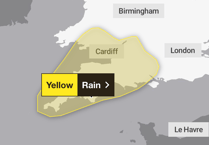Beekeepers are urging people to keep an eye out for yellow-legged Asian hornets (Vespa velutina) and to report any sightings.
The call comes as part of Yellow-Legged Asian Hornet Week, which runs from September 1 to September 7.
While there haven’t yet been any reports of the yellow-legged Asian hornet in Devon, there have been a record-breaking 342 credible sightings elsewhere in the UK this year with 86 nests found.
The invasive species can wipe out honey bee colonies and devastate native insect populations.
‘Even in regions without current sightings, vigilance is vital,’ said a spokesperson from the British Beekeepers Association. ‘A single queen can establish a nest, leading to thousands of hornets and multiple queens next season.’
While the Asian hornet is often confused with harmless, native species, there are some key features to look for. Asian hornets are around 3cm long, so they are smaller than the native European hornet. Their bodies are almost entirely dark brown or black with a single yellowy-orange band near the tail end. And Asian hornets have distinctive yellow legs.

Anyone who thinks they see an Asian hornet should take a photograph or a video and record the location and report it through the free Asian Hornet Watch app, via the UK Centre for Ecology and Hydrology website, or by emailing [email protected]
If an Asian hornet is identified, staff from the government Department for Environment, Food and Rural Affairs (DEFRA) and the National Bee Unit will come to locate and remove the nest.
Asian hornets arrived in France in 2004 and the invasive insect population has spread rapidly. A high number of sightings have been recorded in the UK over the past nine years. As well as arriving on UK shores through imported plants, garden items, freight containers or vehicles, it is thought the hornets could also fly across the Channel.





Comments
This article has no comments yet. Be the first to leave a comment.